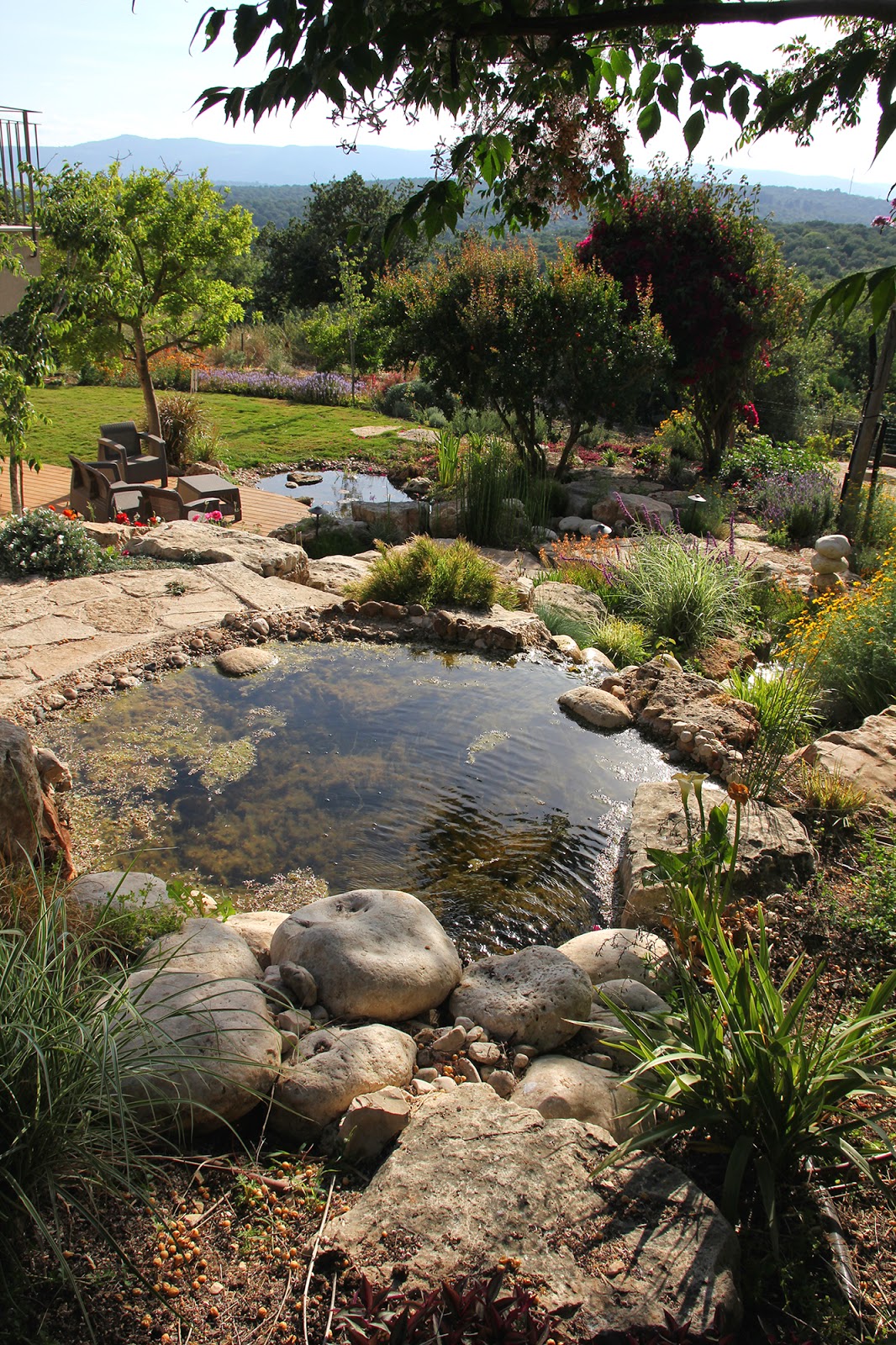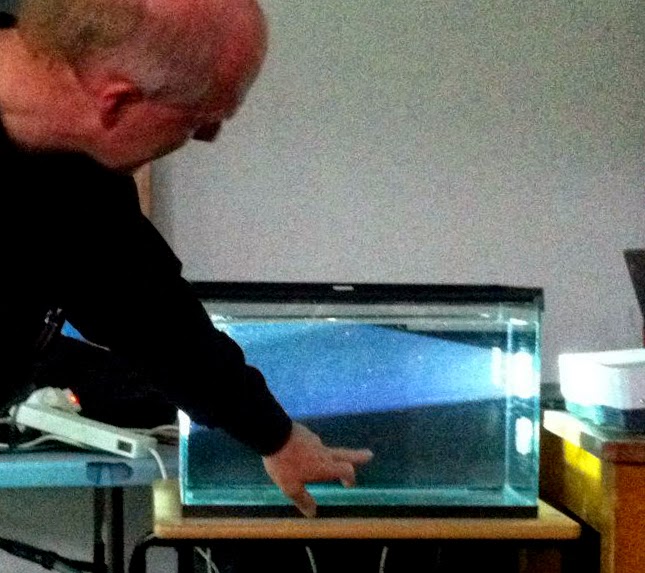Water Retention Landscapes -
transforming the way we think about and manage our natural water resources
A one-day workshop with Bernd Mueller from Tamera, Portugal
at Samania Park, Kibbutz Harduf
"Water, energy and food are freely available for all humankind, when we no longer follow the laws of capital, but rather the logic of nature."
Dieter Duhm, from the Tamera Manifesto for a New Generation on Planet Earth
 On July 31th we had a short, but very intensive and transformative visit of Bernd Mueller, an international expert on the creation of water retention landscapes. Water retention landscapes are an effective tool of reversing the outcomes of desertification, which is an urgent issue of our time in many parts of the world.
On July 31th we had a short, but very intensive and transformative visit of Bernd Mueller, an international expert on the creation of water retention landscapes. Water retention landscapes are an effective tool of reversing the outcomes of desertification, which is an urgent issue of our time in many parts of the world.Desertification as a result of water-mismanagement
 |
| The full water cycle - sketch by Axel Ewald |
 |
| rainwater run-off (source: adlib.everysite.co.uk) |
The worldwide water crisis is not due to natural climate changes or a lack of precipitation, but it is based on our failure to properly manage this precious resource !
The water oasis of Tamera
In the course of the last 8 years Bernd Mueller has transformed the landscape surrounding the Tamera Community in Portugal from a desert-like state into a green Oasis. The climate of the Alentejo area of Portugal, where Tamera is situated, is comparable to that of Israel. Rainy winters (approx 600 mm rainfall per sq. m.) are followed by a short springs and long, hot and dry summers. Inspired by the work of Victor Schauberger, the Austrian philosopher, naturalist and researcher of water, and with the help of Sepp Holzer, an Austrian expert in permaculture, Bernd Mueller created a water retention landscape for Tamera, which is solely based on the optimal management of the annual rainfall. Within this period the Tamera Community has become entirely self-sufficient concerning its water needs.
 |
| Tamera before the water retention project - source: www.tamera.org |
 |
| the Tamera water landscape today - source: www.tamera.org |
Irrigation turned upside down
 |
| the "national water carrier" - source: http://www.masa.co.il |
One of the most striking insights I arrived at as a result of the workshop with Bernd was a profound transformation of my concept of irrigation. In our region, and probably in many other regions of the world with similar climate conditions, irrigation has become an undertaking which is completely detached from the natural water cycle, and even counteracting this natural process. Water is extracted from springs, lakes, groundwater reservoirs and other natural sources. In the case of Israel, huge amounts of water are pumped from the See of Galilee and directed to the rest of the
 |
| drip irrigation |
 |
| sketch by Axel Ewald |
Bernd Mueller put forward the concept of what can be called a "reversed" or "upside-down" irrigation. Water is not withheld but generously given to the earth to be absorbed by the soil, thus recharging the natural "sponge-reservoir" of the earth. As a result the water table will rise and trees, which work as natural "irrigation pumps" can draw water - and with it minerals and other good things - from the deeper layers of the earth. These substances are not "wasted" on the trees. Instead, the tree generously shares these substances, including water, with its surroundings, both in the upper soil levels and in the atmosphere. As a result, the earth as a whole becomes enriched by moisture and minerals, allowing a varied vegetation to develop which in turn shades and cools the earth and attracts further rainfall. In fact, only by using such "reversed" irrigation, the creation of new soil can be vouchsafed.
Down to basics - how to create a water retention landscape?
 |
| swale construction - sketch by Axel Ewald |
The overriding objective of creating a water retention landscape is to design simple devices which help to hold back rainwater, slow down its movement and thus allow water to penetrate into the deeper layers of the soil. This can be achieved by digging channels ("swales") and using the dug-out soil to build dams ("berms") on the downhill side of the swale. These two features together prevent rainwater from running off and allow for a slow penetration of water into the soil.
 |
| water retention landscape with swale and berm - source: http://www.fifthworldlifeway.com/ |
 |
| Swale digging at Explore Prep School, East Oakland, US, source: www.plantingjustice.org |
The soil downhill from the swale/berm element becomes moisturized from within and suitable for growing fruit trees, vegetables and other crops - without additional irrigation. An additional positive effect might become evident after a few years: further downhill the raised water table most likely will give rise to new freshwater springs, providing clean, cool water for plants, animals and man.
This technique is not entirely new. Ancient cultures like the Nabateans in the Negev desert used similar devices to grow crops in arid climates.
 |
| View of the Tamera landscape showing the integration of terraces for water retention source: www.tamera.org |
An extended vision for Samania Park
 |
| Bern Mueller at Samania Park, Kibbutz Harduf, 31.7.2014 |
In his workshop at Samania Park (for details about Samania Park - click here) Bernd Mueller elaborated how the principles of a water retention landscape can be utilized at Samania Park. The aim would be to maximize the healing effect of our initial step of cleansing sewage water by ecological means. But instead of storing the purified water in a large, sterile lake, insulated from the soil by plastic liners and then pumping it through irrigation pipes and drip-outlets, he suggested creating a parallel water retention landscape, fed by the purified sewage water, combining a sequence of smaller ponds with swales and berms and careful planting of suitable trees. Such a landscape will complement the already existing sewage purification plant, create a rich ground for research-work and serve as a showcase for good water-management.
For rounding off the subject, here is a short video about the Tamera water retention landscape:
Water is life. The Water Retention Landscape of Tamera.
Sepp Holzer and Bernd Müller
A film by Grace Media, 12 min.
Camera and editing: Ludwig Schramm
Script: Leila Dregger
Voice Over: Claire-Lilith Suscens, Douglas Baillie
Music: Rui Braga, Kevin McLeod
Photos: Tamera and Krameterhof archive, Ecomeda, Steve Lovegrove
Sepp Holzer and Bernd Müller
A film by Grace Media, 12 min.
Camera and editing: Ludwig Schramm
Script: Leila Dregger
Voice Over: Claire-Lilith Suscens, Douglas Baillie
Music: Rui Braga, Kevin McLeod
Photos: Tamera and Krameterhof archive, Ecomeda, Steve Lovegrove
For further information:
The Tamera Community's page on healing water:http://www.tamera.org/basic-thoughts/healing-water/
A lecture by Bernd Mueller:
http://www.tamera.org/fileadmin/PDF/2.2_The_Secret_of_Water.pdf
Report - Water Symposium at Tamera
http://www.tamera.org/fileadmin/PDF/1310_Wassersymposium_01.6_web_01.pdf














































